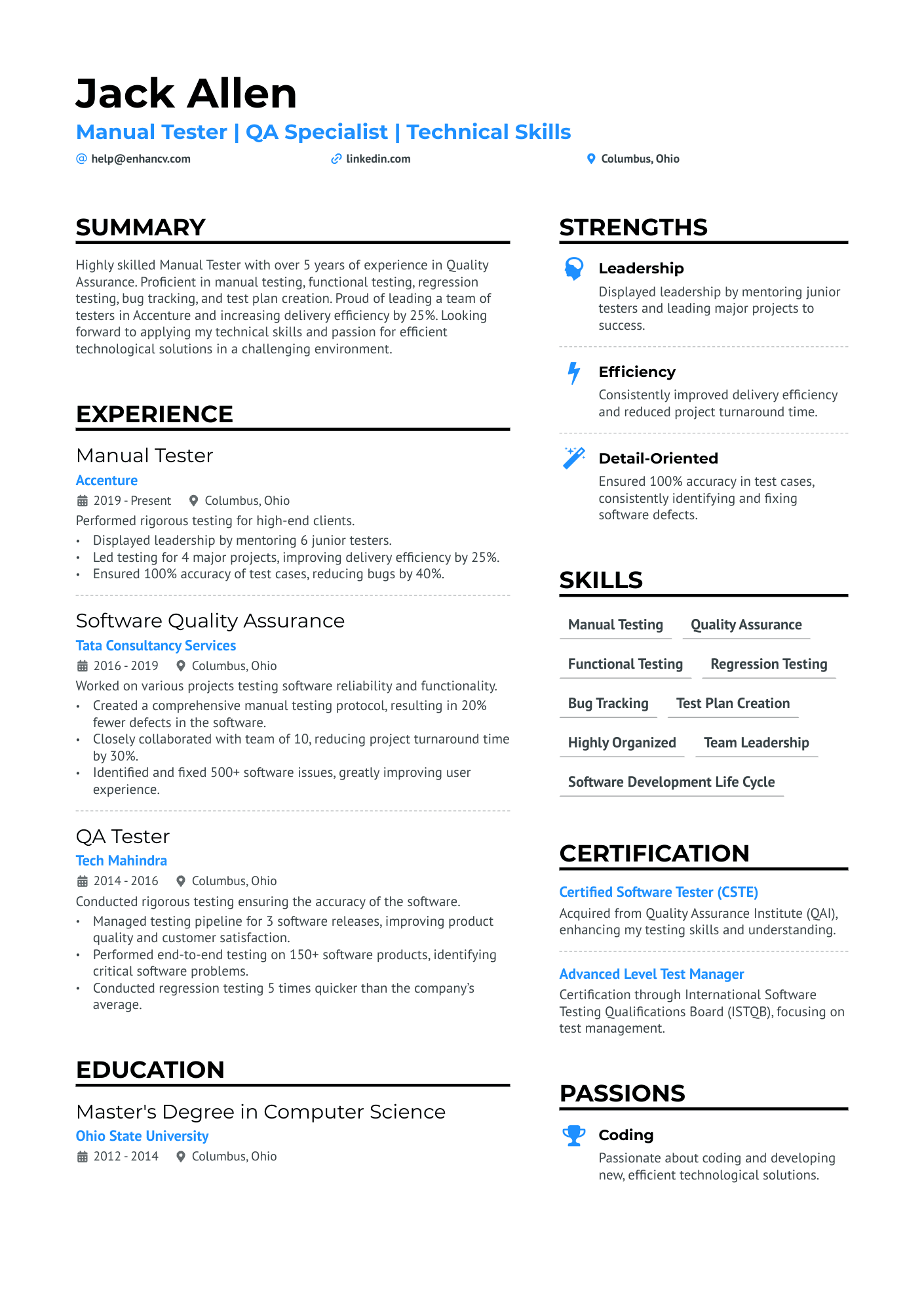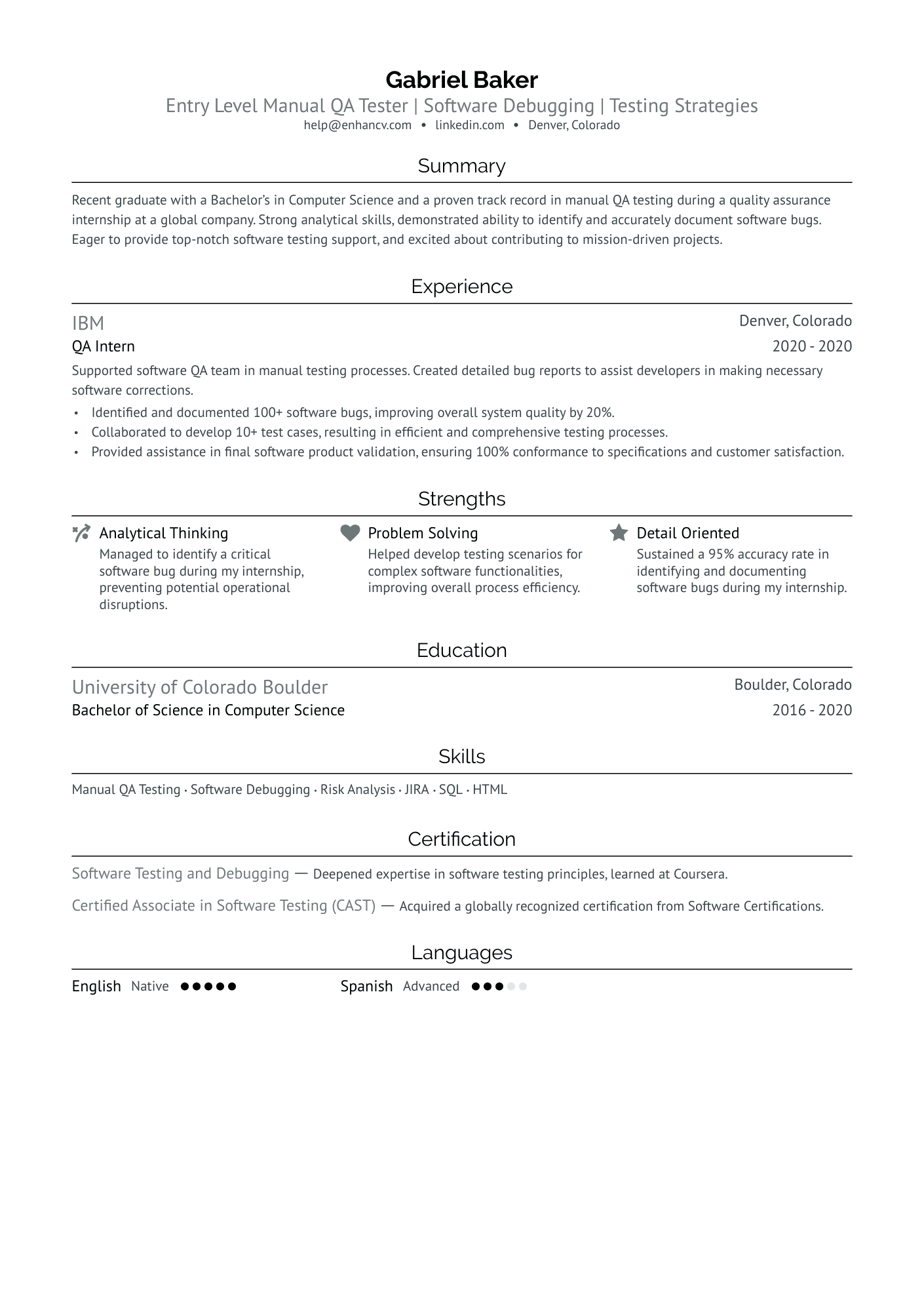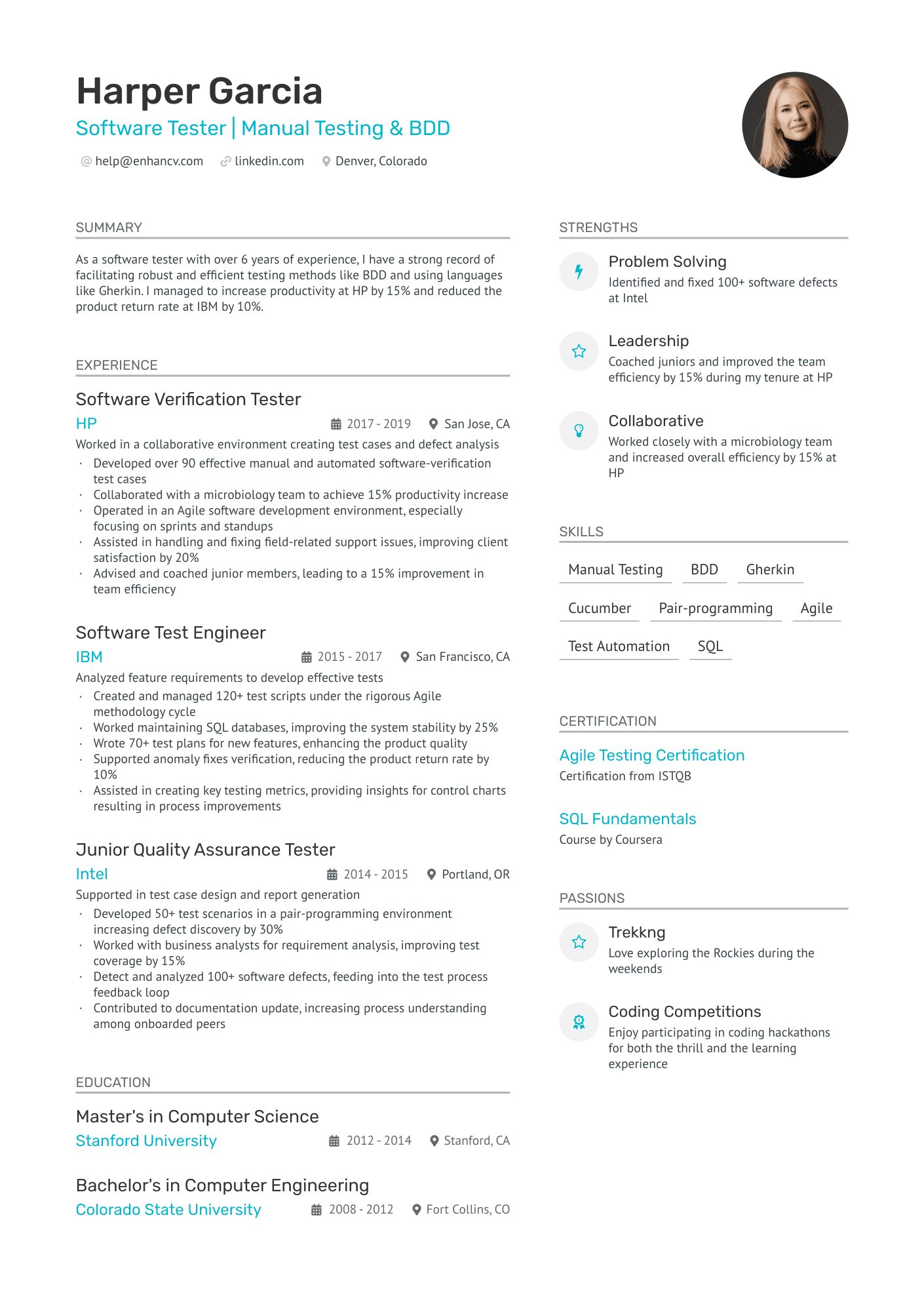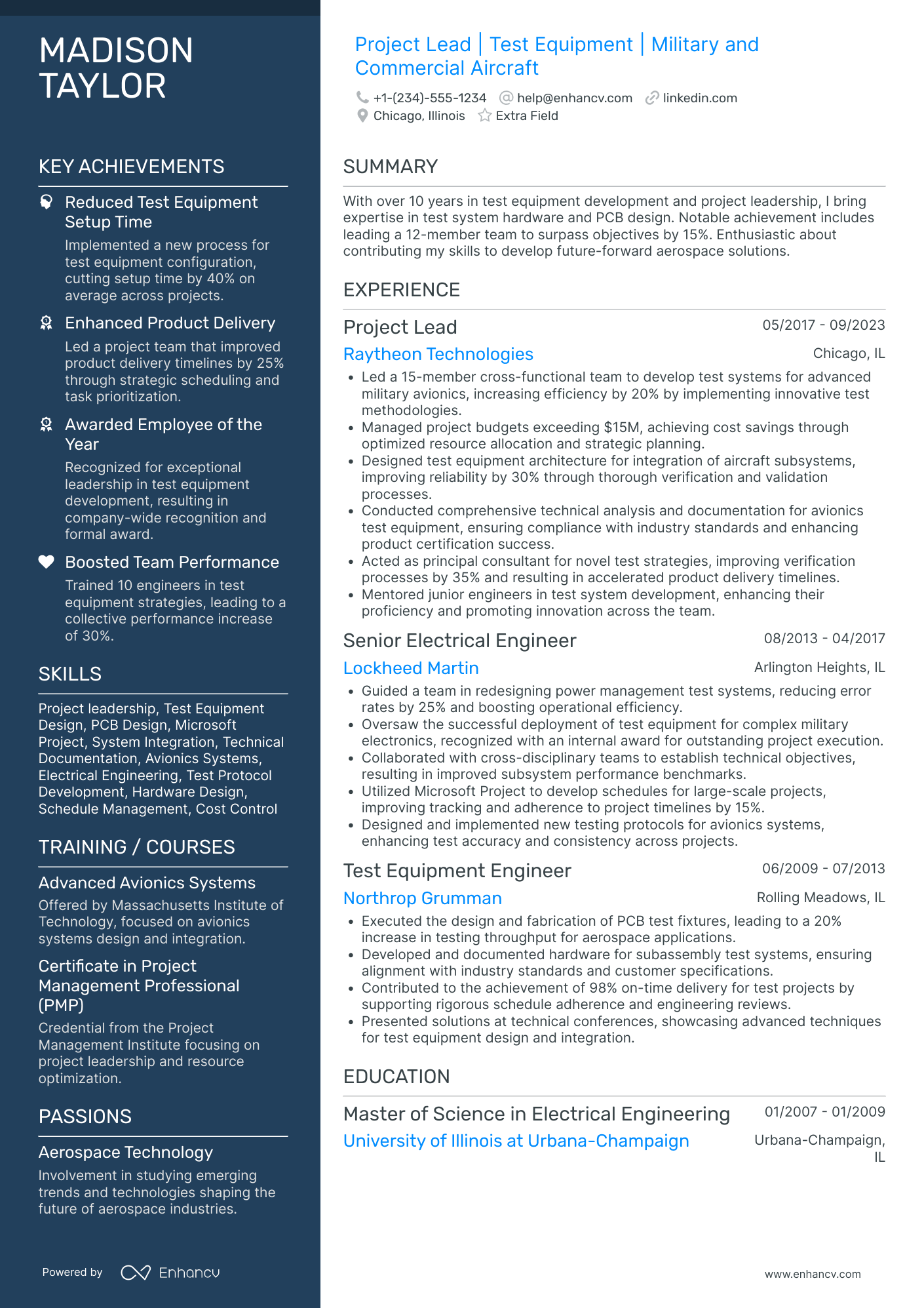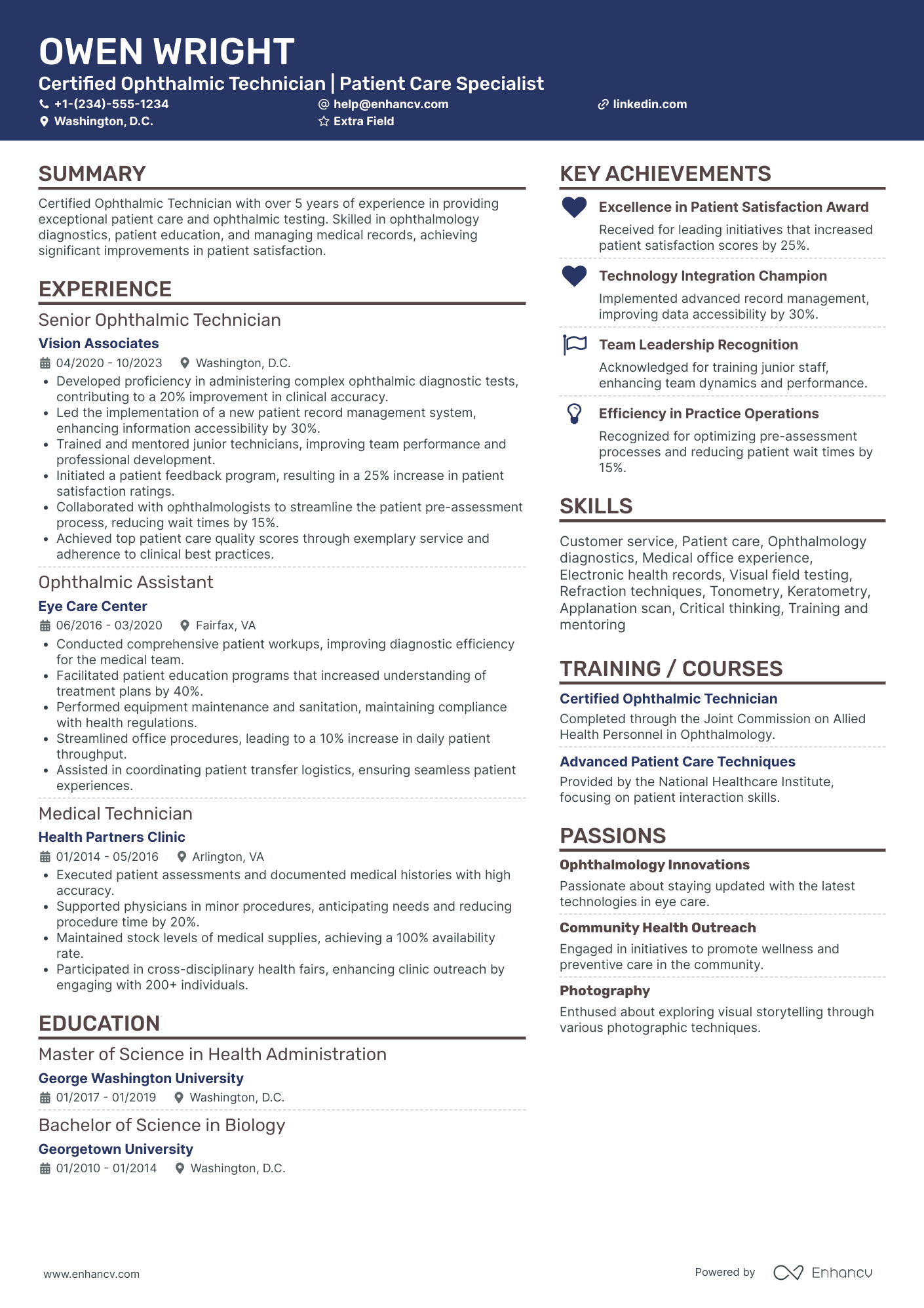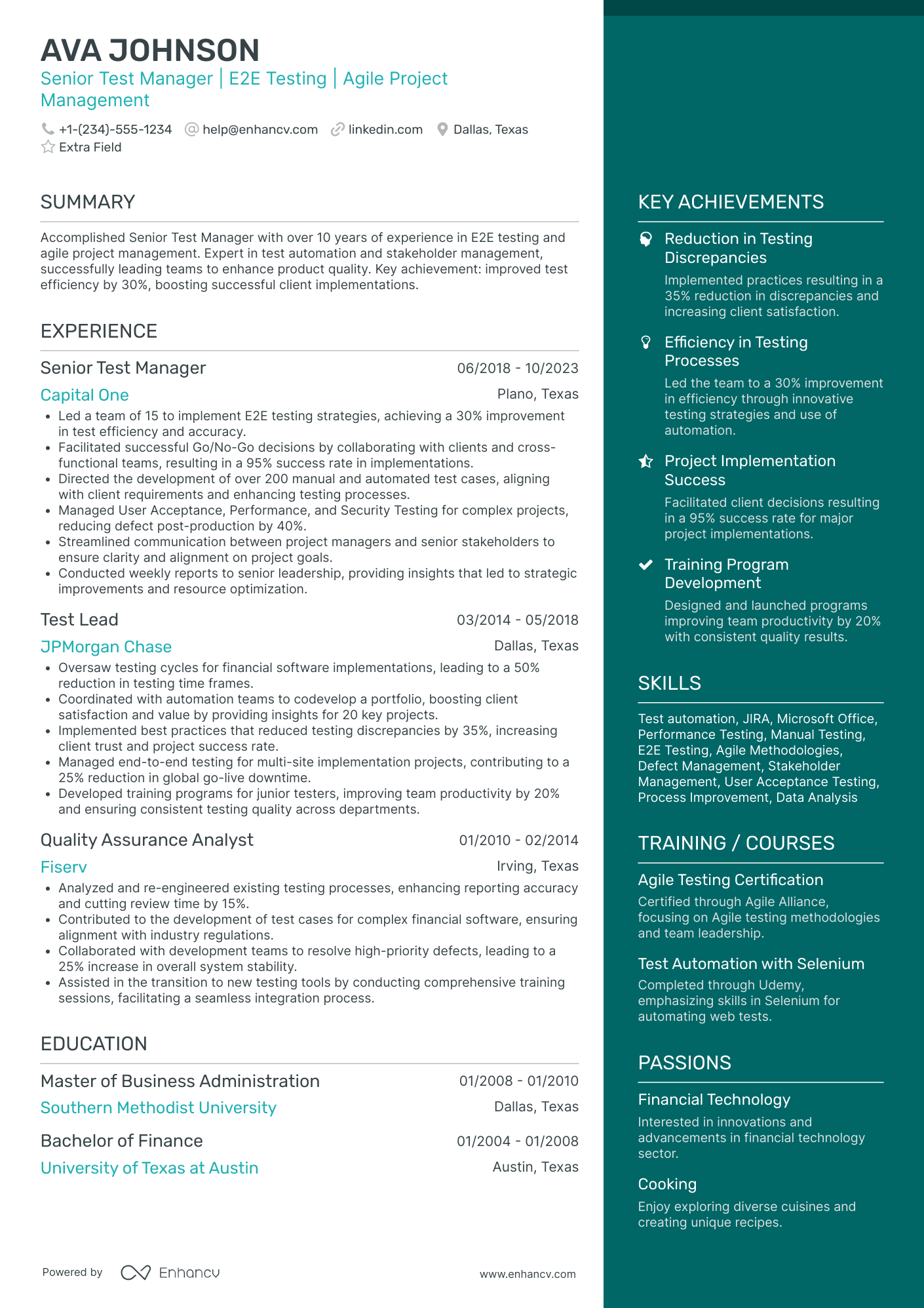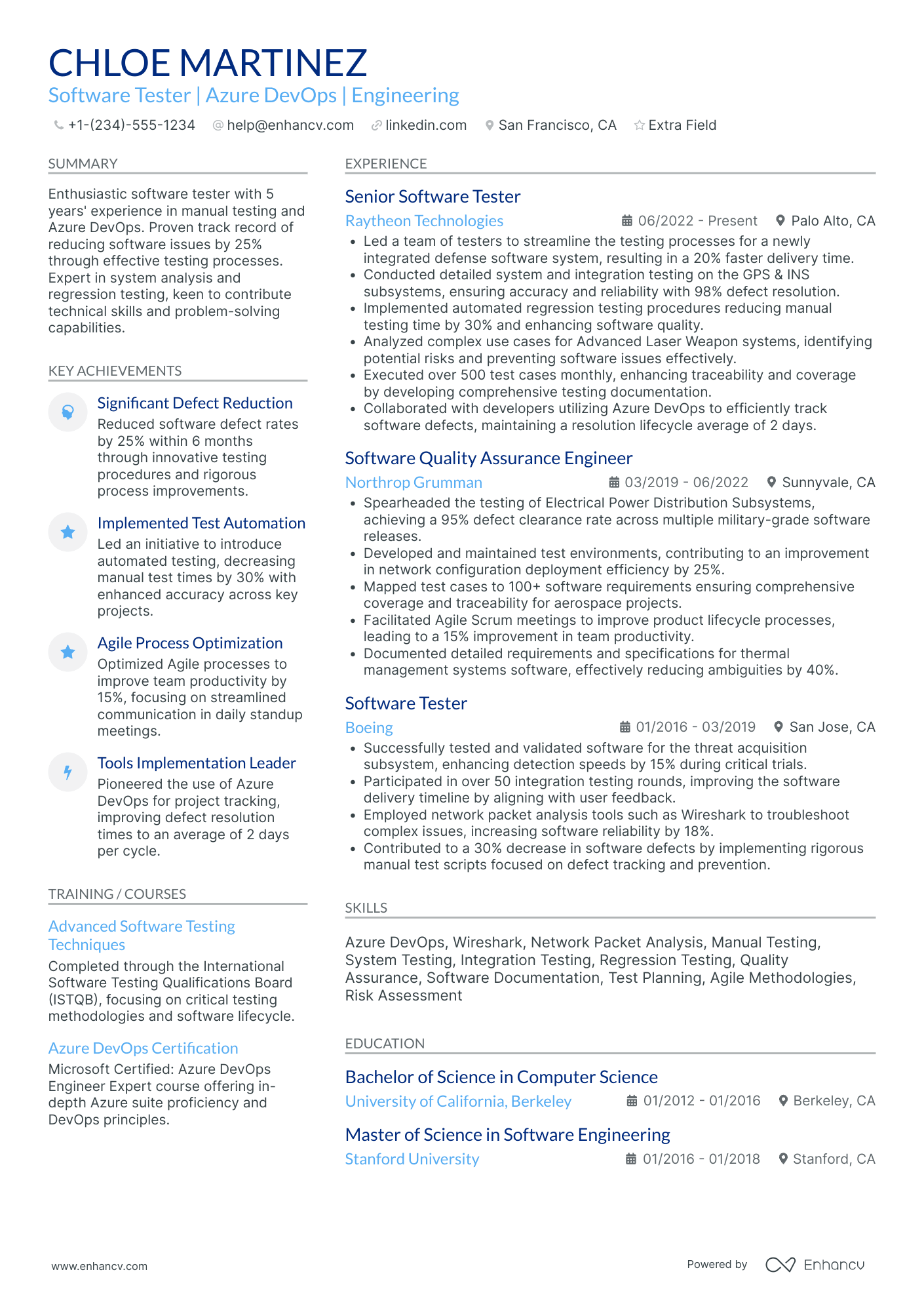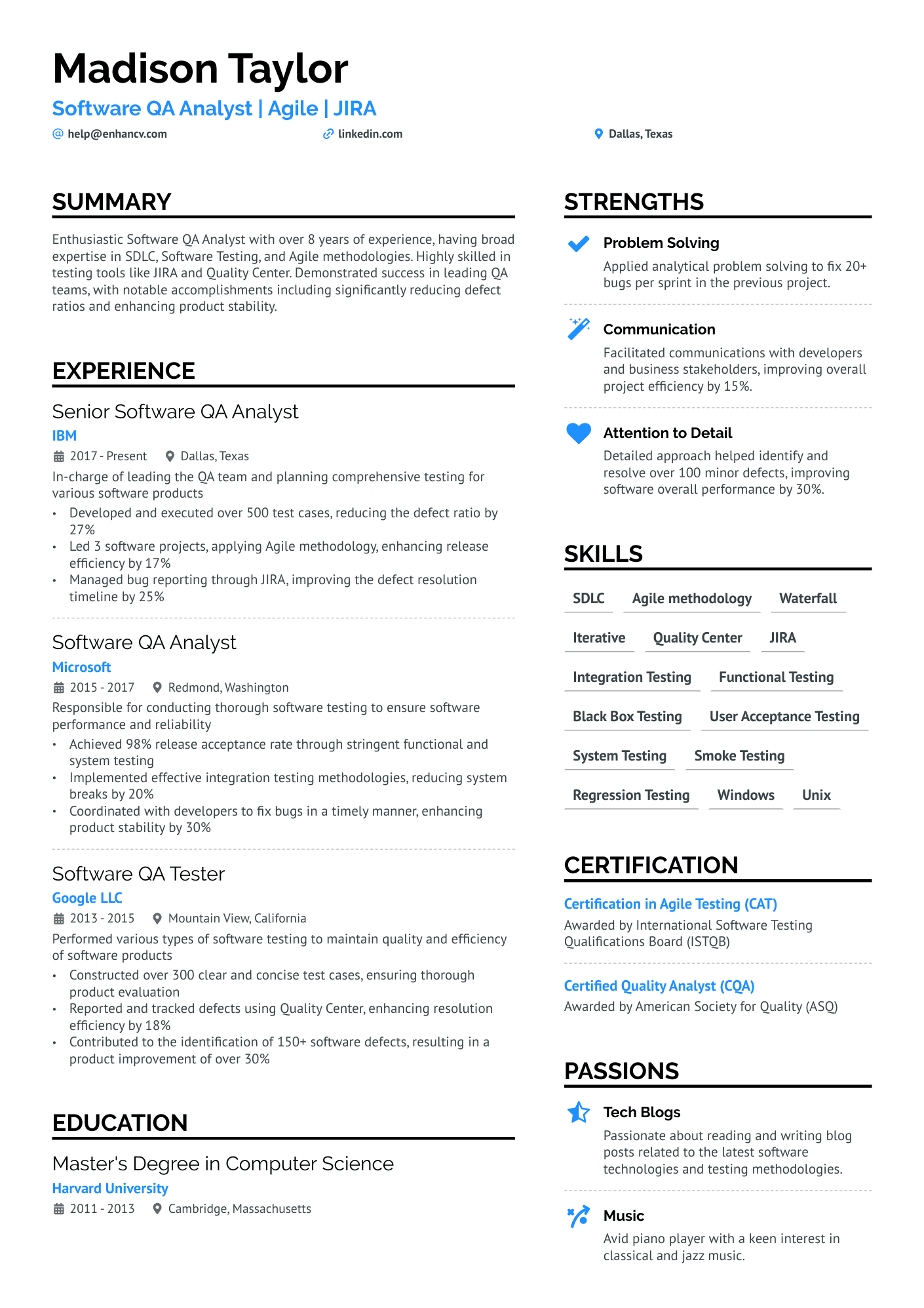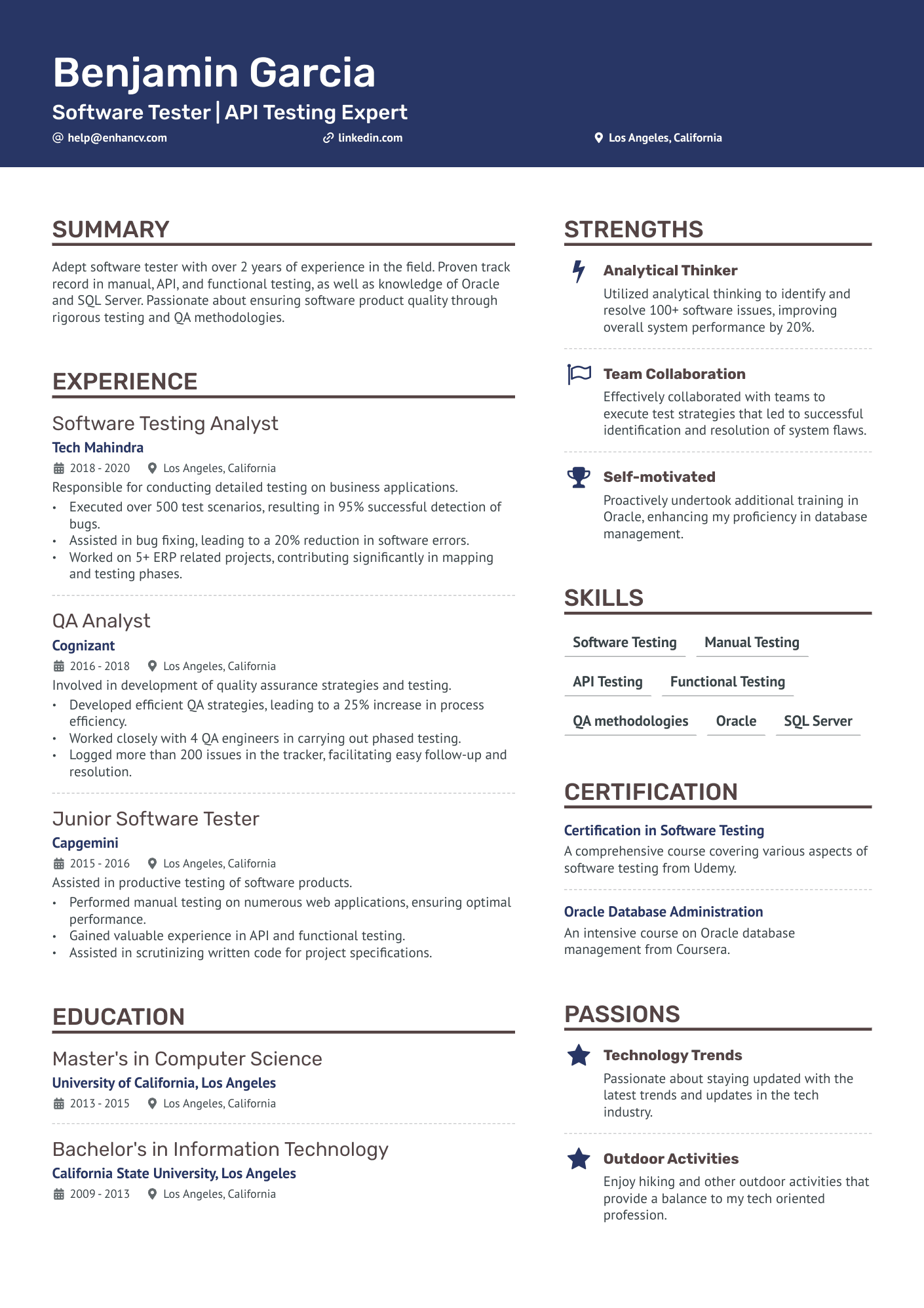Getting noticed as a QA professional is tough. You must prove you’re the jack-of-all-trades recruiters have been searching for all along.
But how do you demonstrate a multifaceted background on your manual tester resume?
Our exhaustive guide will coach you on:
- How to outline your experience by showing you industry-tested resume examples
- How to arrange each section, based on who the prospective employer is
- Which technical skills for manual testers to list on your resume to leave a lasting impression
- How to frame your work history, regardless of how much experience you have
Keep reading for tons of actionable tips, as well as manual tester resume samples!
Manual Tester resume examples
By Experience
Good manual testers are known for their critical thinking and analytical skills. Like good detectives, they have the investigative know-how and years of experience to uncover defects and guesstimate where bugs tend to go into hiding.
How to format a manual tester resume
You may be a QA guru, but your expertise won’t mean anything unless your resume is properly formatted.
Among some of the most common reasons why a resume never reaches a recruiter’s desk is a wrong layout and poor design choices.
Correct formatting is critical to pass the Applicant Tracking System (ATS) checks and, later down the road, win you an interview.
When it comes to your manual QA tester resume, we recommend you:
- Opt for the reverse-chronological resume format if you have more than three years of related experience.
- Use the hybrid resume format, if you’re switching careers or just starting out as a manual tester.
- Include a portfolio with case studies in the resume header to grab hiring managers’ attention from the get-go.
- Be conscious of the length of your resume. You can go over a page, but only if the information you add is absolutely relevant to the role.
- Move the education and certification section near the top of the resume, if you’re applying for a corporate position. Larger companies place emphasis on continuous self-improvement.
- Save your resume as a PDF file unless otherwise stated in the job ad, so none of your formatting and design choices get lost in transit.
Keep in mind the market you’re applying to – a Canadian resume, for instance, might have a unique layout.
Is your resume good enough?
Drop your resume here or choose a file. PDF & DOCX only. Max 2MB file size.
Once you select the general layout of your resume, you must decide which sections to add.
Crucial sections on a manual tester resume:
- A resume header to detail basic personal information and link to your portfolio
- A resume objective or summary to put the spotlight on your professional achievements
- A well-structured experience section to provide an overview of your work history
- A talent segment to feature your top hard and soft skills
- A certificates and education section to outline your additional expertise
Depending on how much practical experience you have, the arrangement of the sections will vary.
If you’re yet to make progress in the QA industry, list the education section near the top of your resume.
But if you’re a tenured professional, start with your work history in a reverse chronological order.
What recruiters want to see on your resume:
- The various types of testing you’ve done so far and how familiar you’re with basic testing concepts. Was your focus more on backend or front-end development?
- What your go-to tools are. Even if some of them are not listed in the job ad, there’s bound to be some overlap. Show recruiters you can learn new things on the go.
- How well you can explain and talk about the projects you’ve worked on. Part of your job entails having excellent presentation skills, so flaunt them.
- How you determine what type of test would be more appropriate for various situations. This indicates you’re very methodical and able to plan ahead, when starting a project.
- How you handle tough challenges or issues you haven’t tackled before. Demonstrate your curiosity, patience and knack for solving difficult issues.
- If you have any experience with test-driven development (TDD). Rarely a product is fully fleshed out before it hits the marketplace. Prove you can work in a constantly changing environment.
- How well you work with other teams and departments. Show you can communicate with individuals with varying levels of tech knowledge and background.
- Display your troubleshooting abilities and strategic thinking skills by discussing how you’ve tackled a non-reproducible bug.
How to write your manual tester resume experience
Generally, manual testing professionals aren’t required to have in-depth understanding of programming languages. As such, the industry has a low entry threshold.
What’s more, this makes most junior QA resumes look almost identical.
So, to stand out among other job candidates, reference tools and tech skills in the experience section whenever possible.
Don’t forget to share how you’ve applied them in practice and what goals you’ve reached in the process.
This will let recruiters determine the current scope of your expertise. And whether you’ll be able to assist with hybrid testing projects in the future.
Another way to ensure you’ve built a powerful resume is to include personal projects which showcase other relevant job skills.
Take a look at the sample experience section and think about what it says about the applicant.
- •Improved test case reusability.
- •Taught junior testers
- •Test requirement coverage and accuracy
- •Reduced report turnaround time
It gives the impression of a very hastily made resume with not much thought put into the writing process. Some of the more glaring issues include:
- The company description doesn’t reveal what was the business focus of Lucas’ past employer. As a result, recruiters won’t know which industries he is knowledgeable about.
- The applicant hasn’t included a company website to elaborate on the projects he was involved in.
- Instead of achievements, Lucas has listed a laundry list duties and responsibilities. Plus, the presented experience doesn’t match the seniority of his position.
- None of the bullet points explain what type of testing was conducted.
- The formatting and punctuation isn’t consistent throughout the entry.
Taking into account the above points, here is an improved version of the example:
- •Improved test case reusability by 33% by reviewing, analyzing and rewriting parts of the existing testing documentation and guidelines.
- •Mentored over 15 junior manual testing specialists on best standards and practices by involving them in ongoing software development projects and teaching them about TDD.
- •Expanded the test requirements coverage to include 86% of the company's top-selling software, thus increasing time allocated for testing custom-made features by a week.
- •Reduced report turnaround time by two days for critical issues after implementing Xray for JIRA as a test case management method for both the development and testing teams.
How to quantify impact on your resume
When talking about your work history, you must be able to quantify your accomplishments.
As you’ve already seen in the example section above, data and numbers play a crucial role in supporting your claims.
Having this in mind, consider factors such as:
- Size of the projects you’ve worked on
- Variety of testing you’re able to conduct
- Overall impact your work has on company work processes
- Number of high-level complexity issues you’ve resolved
- Contribution to corporate achievements (increased income, business scope expansion, etc.)
- Risks you’ve managed to mitigate
- Ability to implement and adapt new tools and methods
- Effective team and cross-team communication
Pro tip
If you have a signed non-disclosure agreement (NDA), remember not to expose any sensitive information when referencing past projects in your resume.
How do I write a manual tester resume with no experience
If you’re switching careers or you’re fresh out of college, there are a few things you can do to build a foolproof resume:
- Review the job description and see how much of the requirements you can match.
- Think about any transferable skills and experience you can bring from past projects.
- Decide whether the hybrid resume format or the functional resume layout would be more appropriate for your case.
- Take into account relevant side projects or competitions you’ve participated in.
- Reference pertinent training or bootcamps you’ve completed.
How to list your hard skills and soft skills on your resume
You won’t always be able to completely align your talents with the job description. And you shouldn’t.
Hiring managers value applicants who are willing to admit when they don’t know something. Still further, they prefer candidates with an intense drive to learn new skills.
So, don’t get discouraged!
This is a good opportunity to balance out your resume skills section. Create a nice mix of your:
- Hard skills - all the top tools and technical skills for manual testers you bring to the table. (Don’t forget that ATS software is programmed to search for such keywords.)
- Soft skills - your strongest social talents and any other relevant transferable skills. These will make you stand out as an exceptional candidate.
Remember, results and data are much more convincing than just empty words. So, for each of the skills you add to the section:
- Think about a situation where your abilities played an important role.
- Share a challenge you’ve had to face and how your talents have helped you.
- Mention how the problem was resolved.
- Consider if there is a way to quantify the outcome of the situation.
Compare the list of skills you have with the ones listed in the job description.
If you’ve already covered the must-have portion of the requirements, here are other key skills you can list:
Best hard skills for your manual tester resume:
- Selenium, LoadRunner, WinRunner
- TestNG
- Jenkins
- Bugzilla
- JIRA
- Testpad
- Cypress, Playwright
- Quality Center
- Cucumber
- Postman
- HTML, XML, JS
- Perl, VB Scripting
- Java, C++, Oracle, SQL, Python, etc.
- Scrum, Lean, Kanban
- MS Office, Power BI, Tableau
- .NET
- VBA Fundamentals
- Confluence
- End-user requirements
- Software development life cycle
Best soft skills for your manual tester resume:
- Quality assurance
- Troubleshooting
- Support
- Testing
- Evaluation
- Task delegation and prioritization skills
- Decision-making skills
- Problem-solving skills
- Critical thinking skills
- Detail-oriented
- Abstract thinking
- Curiosity
- Resourcefulness
- Adaptability
- Communication skills
- Teamwork
- Leadership skills
- Organizational skills
- Time management skills
How to list your certifications and education on your resume
As we mentioned in the beginning of this guide, if you’re aiming to win a corporate position, you must emphasize your academic background.
If you have more than five years of experience as a QA professional:
- Move the education segment under the experience section
- Mention only the highest level of academic qualifications you have
- Avoid listing your GPA because it won’t be as relevant as if you were a fresher
- State the name of the college or university
But if you’re switching careers or a college grad:
- List relevant majors and minors
- Share any related accomplishments, school projects or computer club memberships
- Include your GPA to show you’ve been consistent with your studies
Have a look at the sample education section below for reference:
- •Won the 2022 University of Texas Software Development Jam as part of a four-member team by providing testing and analysis support throughout the software development process
If you want to include a certificate on your resume, always check the date of validity before adding it.
With that in mind, if you’re just starting out as a QA specialist, any of the ASTQB(ISTQB) certifications will boost your chances of getting an interview.
Experienced manual testers should feature advanced-level qualifications, such as CSQA or CQE.
For other essential QA certificates, check out the table below:
Best certifications for your manual tester resume:
- ASTQB (ISTQB) Certifications
- FITA’s Manual Testing Certification Training, 2021
- Certified Software Test Professional Associate Level (CSTP-A)
- Certified Software Quality Analyst Certification (CSQA)
- Certified Quality Engineer (CQE)
- Certified Associate in Software Testing (CAST)
- Certified Software Tester (CSTE)
- Certified Manager of Software Testing (CMST)
- Certified Cloud Tester - Foundation Level (CCTFL)
- Professional Scrum Developer Certification
How to write your manual tester resume summary or objective
Although the experience section is by far the most significant part of your resume, what really gets your foot in the door is the resume summary.
This is the small box at the top of your resume, where you highlight your best career milestones, strengths and qualifications.
If you have lots of QA experience, make sure to choose achievements which make sense for the role at hand. It’s important to show how your expertise will benefit potential employers.
By contrast, if you’re a novice manual tester, write a compelling resume objective.
How is it different from the resume?
Technically, they are very similar in terms of content and format.
But the focus of the resume objective falls mainly on how you will apply your current skills to the benefit of your future employer.
Have a look at the following sample manual tester objective. Do you think it’ll impress hiring managers?
This example doesn’t say much about the candidate, apart from information that could be found elsewhere in the resume.
As a result, Lucas has wasted the opportunity to stand out with a unique talent or an accomplishment. He also hasn’t hinted at how his talents could work in favor of the company.
And while he has listed quite a few skills, there is no mention of how they were applied in practice.
Let’s revise it:
This version is cleaner and provides an excellent overview of Lucas’ abilities and how they were acquired. Plus, the focus is not only on his tech skills, but also social skills necessary for the role.
Last but not least, Lucas shows that he is a competitive individual who adheres to current industry standards and practices.
Optimize your resume summary and objective for ATS
Drop your resume here or choose a file.
PDF & DOCX only. Max 2MB file size.
Additional sections for a manual tester resume
You can always add extra sections with relevant information about your professional growth.
These segments include, but are not limited to:
- Personal projects and case studies
- Publications and conference presentations
- Bootcamp training, hackathons and computer club memberships
- Awards and prizes
How to put a personal projects section on a resume
As with any other tech-related job, personal projects and case studies is what catches the eye of both recruiters and team managers.
When listing a project on your resume, make sure you:
- State the name of your project
- Provide the start and end date of your involvement
- Describe what was the project’s main goal
- Add one or two project-related achievements to highlight the scope of your work
In the end, your entry should resemble the one below:
- •Raised over $2.4 million in investments for the project's core product by advising and supporting a team of 15 developers and business analysts with target audience and end-user requirements identification.
Key takeaways
- Take into account your experience before choosing an appropriate resume format;
- Link to a portfolio with case studies in the header;
- Emphasize how you can contribute to the company’s goals in the summary;
- Lead each experience section bullet point with an action verb;
- List your academic qualifications and relevant certificates;
- Present a well-rounded skills section;
- Feature a personal project which highlights other job-related talents you have.
